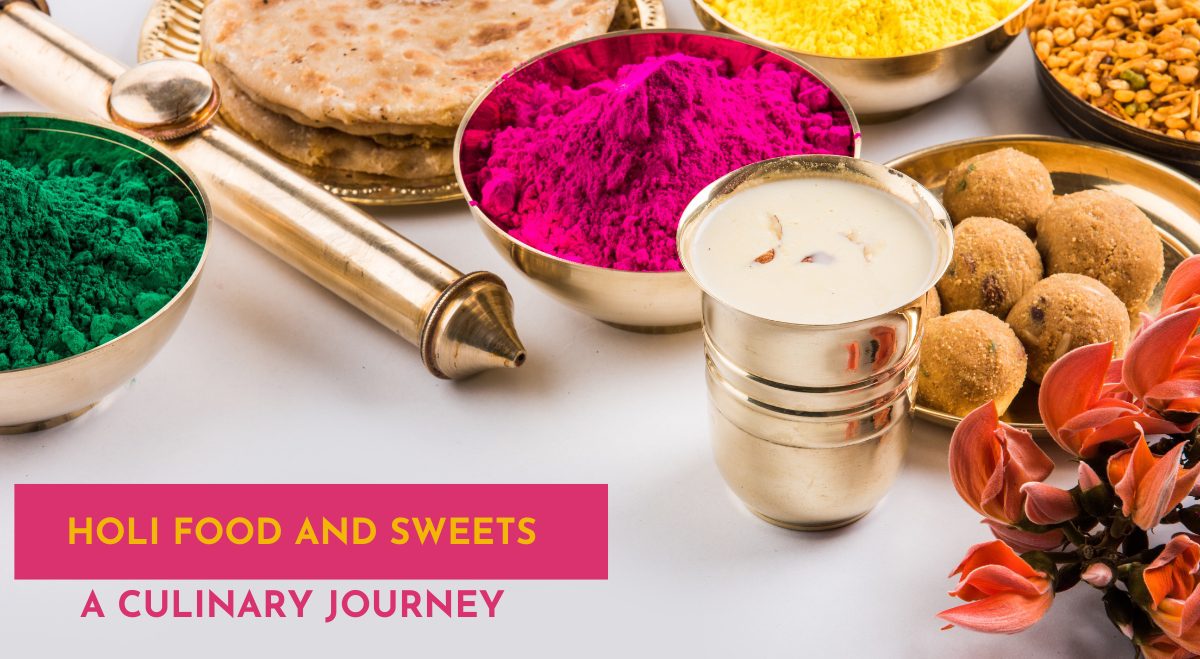Holi, the vibrant festival of colors, is as much a feast for the taste buds as it is for the eyes. As we embark on a delicious journey across India, we’ll discover how each region adds its own unique flavors to this joyous celebration. We’ll explore traditional favorites, their modern adaptations, and uncover the rich history and cultural significance behind these beloved treats.
The Essence of Traditional Holi in Every Bite
Holi foods are more than just delicious; they’re an integral part of the festival’s cultural tapestry. Each dish tells a story of tradition, community, and the changing seasons.
Gujiya: The Sweet Symbol of Holi
Gujiya, a crispy half-moon pastry, is perhaps the most iconic Holi sweet.
Historical Roots: Originating in medieval Rajasthan, Gujiya was created as a durable sweet that could last through long journeys. Its crescent shape is said to represent Lord Shiva’s moon.
Traditional Recipe: Filled with sweetened khoya (milk solids), coconut, and nuts, then deep-fried in ghee.
Modern Adaptations:
- Vegan version: Use coconut oil in the dough and a filling of dates and nuts.
- Gluten-free option: Substitute wheat flour with a rice and almond flour blend.
Cultural Significance: Making Gujiya together has become a cherished family tradition, symbolizing unity and the joy of creation.
Thandai: The Cooling Essence of Spring
This refreshing drink perfectly embodies the spirit of Holi.
Historical Context: Rooted in ancient Ayurvedic practices, Thandai was developed as a cooling tonic for North Indian summers. Its name literally means “that which cools.”
Traditional Recipe: A blend of milk, nuts, and spices like cardamom, fennel, and peppercorns.
Modern Twists:
- Vegan Thandai: Substitute dairy with almond or coconut milk.
- Sugar-free version: Use natural sweeteners like dates or stevia.
Cultural Significance: Thandai’s cooling properties represent the balance of energies during the spring season, aligning with Ayurvedic principles.
A Flavorful Tour of India’s Holi Traditions
As we travel across India, we discover a rich tapestry of regional Holi delicacies, each with its own history and significance.
North India: The Heartland of Holi
- Dahi Bhalle (Uttar Pradesh)
- History: Originating in the Mughal era as ‘Dahi Baray’, this dish became a street food staple in Old Delhi.
- Description: Lentil dumplings soaked in yogurt with tangy chutneys.
- Adaptation: For a vegan version, use coconut yogurt.
- Significance: The cool yogurt symbolizes calming energies after the playful chaos of Holi.
- Kesar Pista Thandai (Rajasthan)
- History: This royal version of Thandai was created in the opulent kitchens of Rajasthan’s palaces.
- Description: Classic Thandai elevated with saffron and pistachios.
- Significance: Represents the grandeur of Rajasthan’s royal Holi celebrations.
East India: Sweet Beginnings
- Malpua (West Bengal)
- Ancient Roots: One of India’s oldest desserts, mentioned in the Rig Veda (c. 1500–1200 BCE).
- Description: Sweet pancakes soaked in syrup, often served with rabri.
- Vegan Option: Use almond milk in the batter and coconut cream for rabri.
- Significance: Symbolizes the sweetness of spring and new beginnings in Bengal’s Dol Jatra (Holi).
- Khaja (Bihar)
- Historical Journey: Ancient Buddhist monks carried a dry version of Khaja on their travels.
- Description: Crispy, layered pastry coated with sugar syrup.
- Gluten-free Adaptation: Substitute wheat flour with rice flour.
- Symbolism: Its layers represent the many facets of joy experienced during Holi.
West India: Festive Flavors
- Puran Poli (Maharashtra)
- Literary Mentions: Referenced in 12th-century Marathi literature.
- Description: Sweet flatbread stuffed with jaggery and lentils.
- Vegan Version: Use coconut oil instead of ghee.
- Meaning: Represents the balance of health (lentils) and happiness (jaggery) in life.
- Ghughra (Gujarat)
- Cultural Fusion: Evolved from the Middle Eastern pastry ‘Ghorayebah’.
- Description: Similar to Gujiya, with regional variations in shape and filling.
- Versatility: Comes in both sweet and savory versions.
- Significance: Its variety symbolizes the diverse flavors of Gujarati cuisine.
South India: Colorful Cuisine
- Holige/Obbattu (Karnataka)
- Ancient Tradition: Mentioned in ancient Kannada literature, over a thousand years old.
- Description: Sweet flatbread with jaggery, coconut, or dal filling.
- Gluten-free Option: Use rice flour for the outer covering.
- Symbolism: Its round shape represents the full moon, often associated with Holi celebrations.
- Kesari Bhath (Tamil Nadu)
- Royal Origins: Believed to have been created in South Indian royal kitchens.
- Description: Saffron-flavored sweet semolina pudding.
- Vegan Adaptation: Use almond milk and coconut oil.
- Significance: Its bright yellow color mirrors the vibrant hues of Holi.
Embracing Holi Food Traditions: Ideas for Everyone
Whether you’re in India or celebrating Holi abroad, here are ways to incorporate these food traditions:
- Regional Holi Feast: Organize a potluck featuring dishes from different Indian regions.
- Inclusive Thandai Bar: Set up a Thandai station with both traditional and vegan options.
- Gujiya Making Workshop: Host a session to learn this traditional art, offering various filling options.
- Color-Themed Menu: Create dishes representing Holi colors, like yellow Kesari Bhath and green Paan shots.
- Historical Food Journey: As you enjoy each dish, share its history and cultural significance.
Conclusion: A Celebration of Diversity and Tradition
Holi’s culinary traditions are a testament to India’s rich cultural diversity and historical depth. From the sweet crunch of Gujiya to the cooling sip of Thandai, each dish carries centuries of tradition while adapting to modern dietary needs and preferences.
As you celebrate the Holi festival, remember that each treat you enjoy is not just a delight for your taste buds, but a connection to ancient traditions, a celebration of regional diversity, and a symbol of the joy and unity that Holi represents.
What’s your favorite Holi dish? Have you tried making any regional specialties or adapted a traditional recipe? Share your Holi food adventures in the comments below. Let’s celebrate the delicious diversity of Holi together!

